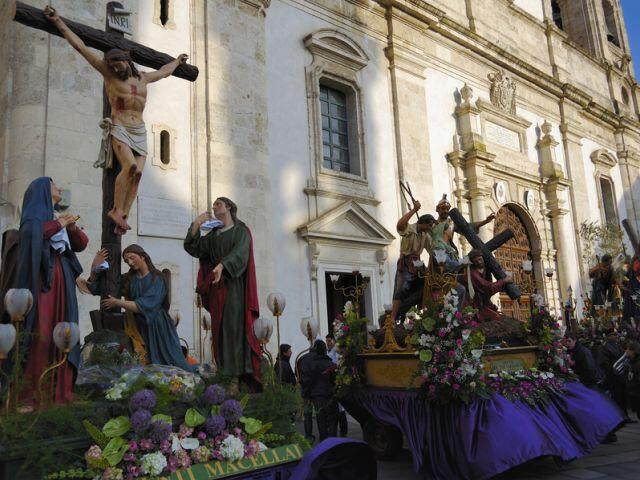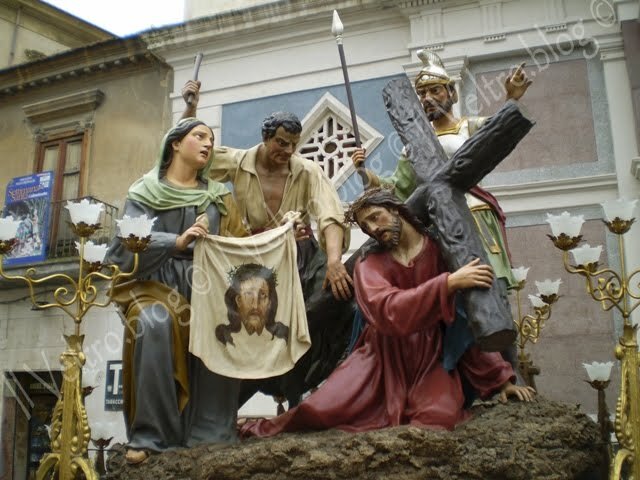Holy Week and Vare in Caltanissetta
Description
Holy Week and Vare in Caltanissetta
Property included in the Register of Intangible Heritage of Sicily (REIS)
----------------
Technical sheet prepared by: Region of Sicily - Department of cultural heritage and Sicilian identity - CRicd: Regional center for inventory, cataloging and documentation and Sicilian regional film library
Intangible Heritage Register
N. Prog. 3
Well: Holy Week and Vare
Book: REI - Book of celebrations
Approval date: 25-01-2006
Category: Easter party
Province: Caltanissetta
Municipality: Caltanissetta
Local name: I Misteri
Chronological News
The procession of the Real Maestranza, which takes place on Holy Wednesday, with its eighteenth-century origins, was declared royal in 1806 at the behest of Ferdinand IV of Bourbon who, on a visit to the city, impressed by the grandeur of the procession, granted the Maestranza the title of " Real".
Historical sources on the Varicedde procession on Wednesday afternoon attest to its origins in the early 1923th century. In 19, some families offered a contribution for the realization of the 10 sculptural groups that went to increase the original nucleus consisting of XNUMX Varicedde.
The origin of the Holy Thursday procession is older. This derives from the ancient ceremony of the Cinque Barette (o Casazza) carried out by the Congregation of S. Filippo Neri, which that same night left its seat, with five small groups of statues, to visit the tombs of the city. Since the 1882th century, the celebration of the Mysteries has taken place in Caltanissetta. Originally the Vare were only seven but over time they expanded to become fourteen in the second half of the nineteenth century, when it was decided to grant the statuary groups to the main city workers. Starting from XNUMX, the celebration saw a strengthening of the interest of the local community, with the commissioning by the Zolfatari of Gessolungo of a new monumental group, the Veronica, as an act of thanks to the escaped danger. From that moment other groups were created or renewed at the behest of private individuals.
Recurrence: Annual
Occasion: Death and Rebirth of Christ the Savior
Function: Devotional and propitiatory
Actors: Members of the various congregations and local workers
Participants: Band group, local community, devotees, tourists
Description
In Caltanissetta, the celebrations for Holy Week begin in the afternoon of Palm Sunday with the procession in the city center of the simulacrum of Jesus Nazarene placed on a boat decorated with flowers. On the Monday and Tuesday preceding Easter, the sacred representations of the Last Supper and the Passion of Jesus, called in dialect, take place in the city streets Scinnence. From Wednesday we enter the heart of the party with the solemn and famous procession of the Real Maestranza which takes place since 1500, in which the representatives of all the oldest local artisan guilds, led by their Captain, move with mourning flags in procession from their seats towards the cathedral, where a rite of regeneration and redemption takes place. The procession in honor of the Blessed Sacrament from the Cathedral continues accompanied by the clergy through the central streets of the city. When the sun goes down on the same day, the procession of the Varicedde, 19 small simulacra that evoke the Product of Holy Thursday. On Thursday evening, the celebration of the Mysteries, is the fulcrum and most spectacular moment of the Holy Week celebrations in Caltanissetta. Starting at 20 pm, the sixteen imposing groups of painted papier-mâché, the so-called "Product”, They walk the streets of the center until late at night. The sculptural groups were almost all made by the artists Francesco and his son Vincenzo Biangiardi at the end of the 800th century, and depict the different moments of the Passion of Christ - The Last Supper, The prayer in the garden, The capture of Jesus, The Sanhedrin , The Flagellation, L'Ecce Homo; The sentence; The First Fall, The Ashen, The Veronica; The Crucifixion, The Deposition, The Pietà, The Translation, The Holy Urn, The Addolorata. The Vare are led respectively by the members of the class to which they belong and by a band, which accompanies the group up to the "Desolata", the culmination of the procession in which with the Spartenza, the separation of the vare, these return to the places where they will be kept for the whole year. The next day, on Good Friday, the procession of the "Lord of the City" takes place, also known as the procession of the "Black Christ" (Christu Nivuru). The simulacrum is the object of strong devotion on the part of the faithful for its miraculous powers. According to the ancient rite, the Maestranza dei Foliarists (gatherers of wild herbs), in a purple dress edged in gold, barefoot on their shoulders the simulacrum from the church of the "Lord of the City" through the streets of the center, singing the "Ladate". The Real Maestranza also takes part in the procession according to the order foreseen in the Wednesday procession. During Holy Saturday and Easter Sunday, the intense moments of commemoration close with the celebration of solemn masses.
REFERENCES
Cardella, Anthony. 2002. Holy rites and legends of the Sicilian people. Palermo: Sigma.
D 'Agostino, Giuseppe. 1997. Celebrate time in New Ephemerides, quarterly culture review. Year X. n. 38. Palermo: Guide.
Flour, Salvatore. 2002. Holy Week in the Province of Caltanissetta. Palermo: Crea.
The Mysteries of the Passion of Jesus: Holy Week in Caltanissetta between religiosity and culture. 2004. Caltanissetta: Lussographic.
Holy Week in Caltanissetta: a guide for tourists. 1989. Caltanissetta: Lussographic.
Discography
Lament Fogliamara 1 - Cricd online tape library
Lament Fogliamara 2 - Cricd online tape library
Excerpts from Holy Friday-Procession of the Black Christ. Lamentances, interviews and plays by the G. Verdi band of Caltanissetta. Caltanissetta 29 March 2002. Nastroteca ND12
Excerpts from Holy Friday-Procession of the Black Christ and Funeral Lamentances. Caltanissetta 29 March 2002. Nastroteca ND11
Footnotes
According to some studies, the “Mysteries” are connected to the ascetic-penitential rituals of the medieval period, and subsequently introduced in Italy and Spain they took the form of theatrical dramatization, over time replaced by statuary groups.
During the procession of the Real Maestranza, the Captain dresses in black, according to the eighteenth-century tradition with tailcoat and felucca with black feather and tricolor cockade, gold fringe at the belt and sword with golden hilt.
During the procession of the Real Maestranza, the Captain dresses in black, according to the eighteenth-century tradition with tailcoat and felucca with black feather and tricolor cockade, gold fringe at the belt and sword with golden hilt.
The 16 Vare of Holy Thursday are almost all the work of Francesco and Vincenzo Biangiardi, with the exception of the Translation of the Neapolitan school. Kept during the year in the warehouses of the Church of San Pio, on the occasion of the procession they are taken to different points of the city where the groups to whom they are entrusted adorn them with splendid flowers, plant elements and lights before the procession. Until 1964 these were carried on the shoulders of about 200 porters, replaced the following year by fercoli with wheels.
Tradition has it that the Black Christ was found by the Foliarists, inside a cave near Caltanissetta, between two lighted candles. Christ was the patron saint of the city until 1625, the year in which the city devoted itself to St. Michael the Archangel, in thanksgiving for having been saved from the plague.
The "Ladate”Are funeral lamentations with a melodic musical system, whose texts in vulgarized Latin vaguely recall medieval lauds, authentic passages of religious poetry. It is a responsorial song in which the soloist's voice alternates with the choir, narrating the passion and death of Christ.
The "Ladate”Are funeral lamentations with a melodic musical system, whose texts in vulgarized Latin vaguely recall medieval lauds, authentic passages of religious poetry. It is a responsorial song in which the soloist's voice alternates with the choir, narrating the passion and death of Christ.
Card Author: Ester Oddo
Go to Google Maps
Send a notice to the publisher
[contact-form-7 id="18385"]







